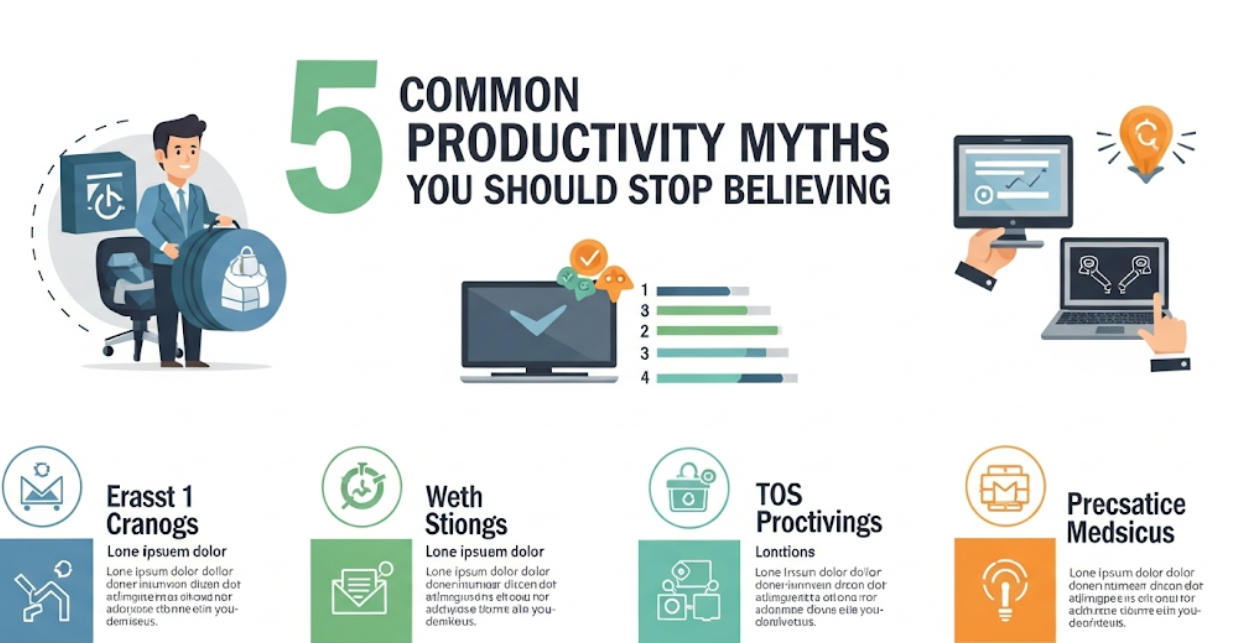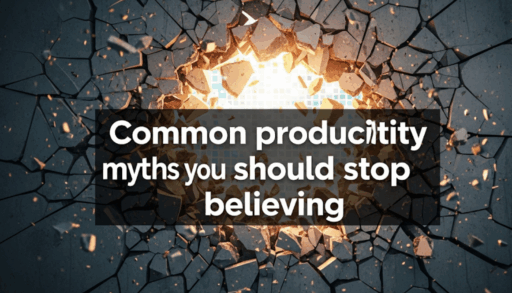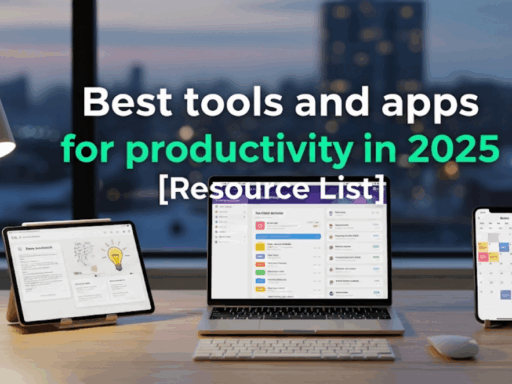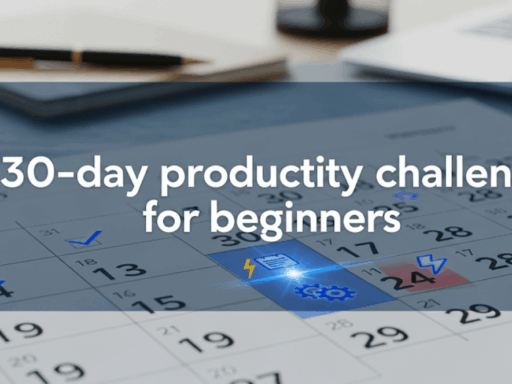Common Productivity Myths You Need to Get Rid of
We live in the era of productivity. From morning routines to time blocking apps, everyone seems to have uncovered the secret formula to do more. The only problem is that much of the advice on being productive is actually myths, which will make you perform even worse than now.
These myths have become commonplace since they were propagated by social media, self-help books, and corporate culture. These myths promise quick ways to increase productivity and solve half of your problems, but lead to numerous burnouts, frustration and worse results.
Now it is time to separate myth from reality and learn what really works. In this article, we are going to debunk the most common productivity myths you have ever heard of. You will learn why it does not work, what real studies say, and most importantly what you need to do instead. Let’s revolutionize the way you think about work.
The Miracle of Multitasking
Why Everyone Thinks it Works
Nearly everyone is convinced that simultaneous work on a few tasks is more effective due to the possibility to get more work done. Even listing that skill on a resume as one of the advantages a person has become popular. People tend to talk on the phone while writing hundreds of emails, listening to podcasts during meetings and keep 10-15 tabs open because it makes them feel more productive.
Indeed, if you spend time on three tasks and perform all of them effectively, it leads to exciting results. Nevertheless, brains do not work this way.
What Science Actually Says
Stanford University indicates that people who multitask constantly perform under average on every metric. They cannot filter out irrelevant information, manage their memory and quickly switch tasks. The process really distracts your brain, which thinks in the following schemes:
- Your brain switches attention between tasks
- This switching penalty that is placed within every switch slows you down
- Errors and omissions occur in greater numbers
- Takes 25% longer to complete tasks on average
- Your stress levels increase significantly
A Better Way to Work
Instead of resorting to multitasking, use these tried-and-true approaches:
- Single-tasking: Do one task 100% before you move on to the next
- Task batching: Group similar tasks (e.g., answer all emails at once, handle phone calls together)
- Time blocking: Set aside certain parts of your day to work on specific types of tasks
- Priority lists: Prepare a list of the most important tasks that need your attention and always start with number 1
The Dangerous Myth of Working Longer Hours
Why We Worship the Grind
On social media, we see entrepreneurs boasting about 80-hour work weeks. The inference here is quite simple: successful people just work harder and longer than everyone else. A lot of people are led to believe that productivity = number of hours working due to this “hustle culture.”
This myth is so toxic because it does not ultimately have any connection with the way humans actually work, biologically or psychologically. Your brain is not a machine capable of being kept on all the time.
The Hidden Costs of Overworking
The World Health Organization research has some awakening facts:
| Hours Worked Per Week | Productivity Level | Health Impact | Error Rate |
|---|---|---|---|
| 40 hours | 100% (baseline) | Normal | Low |
| 50 hours | 95% | Mild stress | Moderate |
| 60 hours | 85% | High stress | High |
| 70+ hours | 70% | Severe burnout | Very High |
Working more than 55 hours has been associated with an increased risk of stroke by 35 percent and heart disease by 13 percent. In addition, productivity generally begins to drop after 50 hours of work per week.
Smart Work Strategies That Will Boost Your Productivity
Focus on these evidence-based approaches:
- Manage your energy: Work during natural energy peaks
- Regular breaks: 15 minute break every 90 minutes
- Good night sleep: Ensure 7–9 hours of rest
- Scheduled rest: Downtime means recharging your mind
- Boundaries: Establish working start/stop times
The Perfect Morning Routine Fantasy
The 5 AM Success Story Worship
Many productivity gurus advocate 5 AM (or earlier!) wake-up times. They say that everyone who’s successful is rising before sunrise, having a super-fruit smoothie, meditating for hours, journaling about the meaning of life and they’ve achieved more by 8 AM than most do all day.
This myth has created guilt and shame in people who struggle to get up at 5 AM or even 6 AM. Though the motivational posts sound inspiring, there is more to it.
It’s Your Chronotype, Not Your Alarm
Put simply, your chronotype is whether you’re an early bird or a night owl, and it’s largely genetic. Approximately a quarter of individuals are natural “larks,” happiest in the early morning hours; another quarter are innately “owls,” creatures of the late night, and the remaining fifty percent falls somewhere in between.
Studies at the University of Toronto revealed that when people work during their optimal hours, they perform best.
Morning People (Larks):
- Prime Time: 8 AM to 12 PM
- Ideal for: Creative tasks, important decisions
- Energy crash: 2 PM – 4 PM
Evening People (Owls):
- Prime Time: 2 PM — 6 PM, AND 6 PM —10 PM
- Best for: Analytical tasks, problem-solving
- Slow start: Before 10 AM
Creating A Routine You Can Stick To
Instead of forcing yourself to fit into someone else’s schedule:
- Discover your chronotype: Monitor your energy levels for a week
- Prioritize important work: Schedule your most important work during your peak hours
- Guard your prime time: Reserve the peak energy hours for deep work
- Tailor your routine: Include habits that complement how your body operates
- Drop the guilt: Waking up early does not make you a better person
The Perfectionism Productivity Trap
When Done Right Turns into Never Done
Perfectionism disguises itself as an asset for being productive. Perfectionists think that spending extra time getting every detail correct contributes to better performance and greater success. The appeal of this myth is that perfectionist work often appears to be superior on the surface.
It turns out that perfectionism is actually one of the worst productivity destroyers. This results in paralysis by analysis, extended timelines and ironically, poor outcomes.
The Actual Price of Perfectionism
Perfectionism creates several destructive patterns:
- Analysis paralysis: Planning too much, doing too little
- Revision loops: Editing and tweaking infinitely with no real progress
- Procrastination: Postponing due to non-ideal conditions
- Opportunity cost: What else you could be doing instead of perfecting a less important task
- Burnout: Exhaustion from unsustainable standards
The Power of “Good Enough”
The 80/20 rule (AKA The Pareto Principle) says that 80% of your results will come from just 20% of your efforts. This means:
- 80 percent perfect is usually just as good as 100 percent perfect
- 80% of the time is spent on the final 20% polish
- Good enough makes room for other things that have just as much impact
When to aim for perfection:
- Life-critical work (surgery, engineering calculations)
- Final presentations to key stakeholders
- Legal documents and contracts
When “good enough” is better:
- First drafts and initial versions
- Internal communications
- Routine tasks and processes
- Time-sensitive deliverables
The All-or-Nothing Goal Setting Mistake
The Big Goals Equal Big Results Wrong Idea
A lot of popular productivity advice focuses on huge, life-changing goals. The thinking goes: giant goals = more motivation = bigger outcomes. Social media advances this notion, showcasing people with extraordinary goals and transformations.
This myth does not take into account how our brains really work around goals and motivation. Studies have shown that stretch goals can often backfire, leaving people obsessed with reaching larger targets at their own expense.
The Real Reason Massive Goals Fail
Big goals lead to all sorts of psychological problems:
- Overwhelm: The distance between where we are and the ideal state seems unattainable
- Black-and-white thinking: Small setbacks = complete failure
- Delayed gratification: The feeling of never really achieving anything
- Motivation decay: If results aren’t coming quickly, excitement fades
- Analysis paralysis: Too many steps and decisions to move forward
The Science of Small Wins
Harvard Business School research says that incremental progress is more rewarding than infrequent big wins. The “progress principle” explains why:
- Dopamine is released by the brain during small wins as positive reinforcement
- Progress builds confidence and momentum daily
- Micro-goals reduce resistance and procrastination
- Compound results lead to huge long-term gains
Effective goal-setting strategies:
- Break it down: Turn big goals into small, specific and achievable daily tasks
- Focus on process: Control what you do, not what happens
- Celebrate small wins: Acknowledge any progress to maintain motivation
- Follow the 2-minute rule: If it takes less than 2 minutes, do it right now
- Stack habits: Attach new habits to existing routines
The Technology Solution Illusion
The App That Will Change Everything
There are already thousands of new productivity apps vying for your attention every month. Whether it pertains to complex project management systems or AI-powered scheduling tools, technology appears to contain the cure for all productivity woes.
This myth suggests that the right app, system or tool can help you significantly boost your productivity while doing all the heavy lifting. Yes, technology can be helpful. That said, technology is not the solution for most productivity problems.
Too Many Tools, Loss of Productivity
The reality of productivity technology:
- Tool switching cost: Managing multiple apps means time and brain space
- Setup costs: Time spent learning new systems before actual work
- Feature overload: Complex tools often create more problems than they solve
- Maintenance cost: Keeping systems updated and organized is work itself
- False productivity: Organizing your to-do list is not doing work
Simple Systems That Actually Work
The most effective people operate with tools that are deceptively simple:
For task management:
- Paper notebook and pen
- Simple text file or note app
- Basic calendar application
- Email task organization
Key principles for any system:
- Capture everything: Write down everything on your mind
- Review regularly: Process captured items on a regular basis
- Keep it simple: Use the minimum viable system
- Make it portable: Easy accessibility wherever you are
- Refine periodically: Regularly assess and optimize your system

The Busy Equals Productive Confusion
When Motion Replaces Progress
Contemporary work culture equates busyness with being valuable. People wear their busyness like a badge of honor, thinking it somehow equates to being worthwhile and significant.
What makes this myth extremely dangerous is it only looks at inputs (time spent). You can be extremely busy and achieve nothing of significance.
Busy Work vs. Real Work
Busy work characteristics:
- Feels urgent but isn’t important
- Creates the illusion of progress
- Lots of meetings and emails
- Focuses on activity, not results
- Makes you tired but unfulfilled
Real work characteristics:
- Directly contributes to important goals
- Creates measurable value or progress
- Requires deep focus and thinking
- May feel challenging but rewarding
- Produces tangible results
How to Escape the Busy Trap
- Track your time: Record how you use your 168 hours over a week
- Apply the Eisenhower Matrix:
- Urgent + Important = Do first
- Important + Not urgent = Schedule
- Urgent + Not important = Delegate
- Not urgent + Not important = Eliminate
- Learn to say no: Save your time for high-value work
- Batch similar tasks: Schedule emails, calls and meetings into time blocks
- Measure results: Success is measured by output, not time spent
The One-Size-Fits-All Productivity System
The Silver Bullet That Doesn’t Exist
Most productivity books and courses advertise that their system works for everyone. These techniques, whether Getting Things Done, the Pomodoro Technique or time-blocking are presented as though they are universal solutions.
This myth leaves out personality differences, workplace dynamics, natural energy rhythms and life circumstances.
Why Personality Matters in Productivity
Studies demonstrate that different personality types succeed with different approaches:
Introverts vs. Extroverts:
- Introverts: Quiet spaces, fewer interruptions, longer focus times
- Extroverts: Collaboration, variety and social accountability
Detail-oriented vs. Big-picture thinkers:
- Detail-oriented: Structure, order and checklists — following one step at a time
- Big-picture: Flexibility, creative freedom, outcome-oriented approach
Planners vs. Spontaneous types:
- Planners: Detailed schedules, preparation and routine
- Spontaneous: Flexible systems, reactive scheduling, variety
Building Your Personal Productivity System
Instead of following someone else’s system entirely:
- Self-assess: Understand your natural tendencies and how you work best
- Start with basics: Focus on fundamental principles before complex systems
- Test slowly: Try one technique at a time
- Measure what works: Track results, not just effort
- Adapt as you go: Customize systems as your life changes
Moving Beyond Productivity Myths
The road to true productivity begins with discarding the attractive myths that do not serve you. These false beliefs appear to improve your performance when in reality they just stress you out, make you feel guilty and frustrated, and prevent you from finding what actually works.
True productivity is not about working harder, longer, or with more tools. It’s about working smarter by:
- Focusing on what matters most
- Working with your natural rhythms
- Creating sustainable systems
- Measuring results, not just activity
- Managing your physical and mental energy
Your Next Steps
- Identify your myths: Be honest about which myths might be holding you back
- Focus on one area: Trying to change too much too fast will overwhelm you
- Try evidence-based alternatives: Test new approaches for at least two weeks
- Measure both performance and well-being
- Be patient with change: Real transformation takes time
Remember, the most productive people aren’t using the latest productivity fads. They have sustainable systems that work with their values, energy and goals. Stop chasing productivity myths and create frameworks that actually fit your life.
The path to becoming more productive is simpler than you think — but it requires letting go of myths that promise quick fixes and accepting that real change comes through consistent habits and self-awareness. By making this mindset shift, your future more productive self will thank you.




